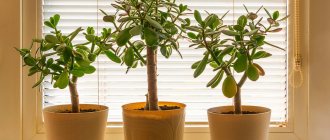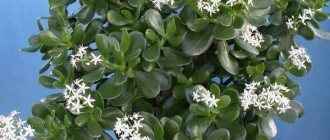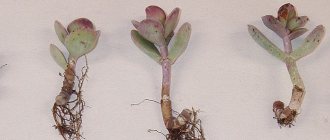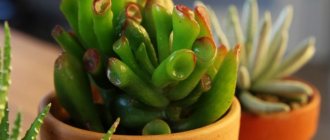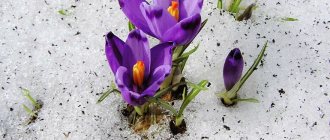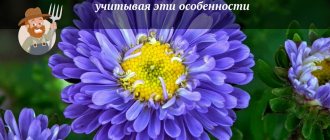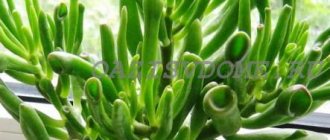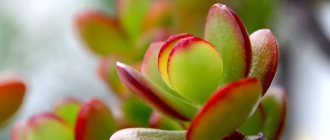Updated: May 23, 2022 / Crassula
Crassula got its Russian-language name for its dense succulent leaves. I like the tree-like types of Crassulas for their ease of formation and the possibility of obtaining an original man-made tree. These wonderful plants have a thick, woody trunk, the cuts of which quickly become overgrown. Crassulas are best formed by pruning and stretching.
Crassulas are very unpretentious in care. In winter, they require almost no attention - just keeping them cool (in my conditions, it’s a window sill, right next to the glass) and watering once a month, when the leaves become slightly lethargic. In summer, without shading, plants sunbathe on the loggia from the end of March to November, withstanding differences in night-day temperatures.
In hot summer weather, if the fat plant is placed on a sunny windowsill indoors, you need to water it carefully - in the evenings, almost every day. At temperatures of 30–40 °C, plants become stagnant and can easily rot after untimely heavy watering.
The following species of tree-like crassulas were in my collection.
Crassula ovata obliqua
Crassula ovata obliqua is distinguished by its characteristic pointed tip of the leaf. A striking representative of this variety of Crassula is the variegated Crassula ovata obliqua var. Tricolor with pure white chlorophyll-free stripes on the leaves:
Crassulla Tricolor
Crassula Tricolor grows slower than other species and branches reluctantly. In good light, the underside of the leaf takes on a rich crimson color.
Home care
Be careful: direct sunlight hitting the leaves can burn them! If you place the plant on southern windows, you can arrange a little shading if necessary. When there is not enough light, Sunset may shed its leaves.
Don’t rush to water if you see dry soil in a pot: leave everything as it is for a few days. During cold wintering, Crassula is watered no more than once a month. If it was not possible to organize a decrease in temperature in autumn and winter, then we water more often.
Recipe for “homemade” soil: part turf soil – part leaf soil – part peat – part well-washed river sand. For drainage, add small pieces of broken brick and a little activated carbon (prevention of the development of root rot).
Crassula ovata cv. Hummel's Sunset
Crassula "Sunset" has a pronounced red edge along the yellow edge of the leaf:
Crassula ovata cv. Hummel's Sunset
The most amazing thing is that my specimen, purchased in a store, after a month on a sunny windowsill lost all this beauty and turned into an ordinary green-leaved Crassula ovata. But there is no doubt about the existence of this variety - there are photos of wonderful adult specimens on the Internet.
Photos and names of varieties of Succulent Crassula: what types of Money Tree are there
Known for its plump branches, jade hue, glossy leaves and pink flowers, Crassulas are found throughout the world. Many varieties have been cultivated for decades and have received high awards. For example, the variety Sunset (C. ovata cv. Hummel's Sunset) received the Royal Horticultural Society's Award of Garden Merit.
Tree-like
Tree Crassula (Crassula Arborescens) is also known as the Silver Dollar plant or Blue Buddha Bush. It is a slow growing shrub that has silver-blue leaves with burgundy edges.
Photo used as illustration. Source: Yandex.Images
Flowers appear at the tips of the stems in autumn and winter and bloom for a very long time. The height of the plant is limited by the volume of the pot, but usually the flower does not rise above 60 centimeters.
Blue bird
Also among the varieties of Tree Crassula there is “Blue Bird” (Crassula Arborescens Blue Bird). Like most Money Trees, this Succulent grows very slowly.
Photo used as illustration. Source: Yandex.Images
But the plant stands out for its color - a mixture of shades of aqua, green and red. The maximum height of the flower is about 50 centimeters, but its size can be reduced by using a small pot.
Wavy
Crassula Aborescens Undulatifolia was first bred in 1974. This flower is often used in architecture and for decorative purposes.
Photo used as illustration. Source: Yandex.Images
Its waxy leaves set it apart from other types of succulent plants. In addition, the tree is an ideal candidate for growing in bonsai style.
Ovata
Crassula Ovata is the most popular type of Money Tree. This is the original variety, which is the most common among Crassula.
Photo used as illustration. Source: Yandex.Images
This plant is hardy and grows quickly. Pinkish-white buds appear at the tips of the stems in winter, and the flower height in some cases exceeds 2 meters.
Hobbit
A widely known succulent among bonsai enthusiasts, this variety of Crassula Ovata Hobbit is named after the fictional race of people from J. R. R. Tolkien's The Lord of the Rings.
Photo used as illustration. Source: Yandex.Images
As the name suggests, this variety has a small height, not exceeding 30 centimeters. At the same time, the plant looks great in combination with other Succulents.
Gollum
This species of Crassula ovata Gollum has become famous due to the interesting formation of its leaves. This is a robust evergreen succulent variety that develops quite slowly and can grow up to 120 centimeters tall.
Photo used as illustration. Source: Yandex.Images
Its fleshy foliage resembles Shrek's ears - bright green, tubular with red tips. With proper care, you can see pinkish buds closer to winter.
Hummels Sunset
The variety Sunset (Crassula Ovata Hummel's Sunset) was awarded by the Royal Horticultural Society in 1993 for its showy foliage color and thick trunk. This is what made the plant especially popular.
Photo used as illustration. Source: Yandex.Images
During the arrival of winter, the color of the leaves of this Crassula changes to reddish-golden. This is a great plant to place in the center of your dining table.
Minima
Crassula Ovata Minima is known as a miniature Money Tree. This is an extremely branched flower that looks quite attractive.
Photo used as illustration. Source: Yandex.Images
The tree can grow up to 60 centimeters high and looks great on the balcony. In addition, a miniature flower can be an excellent gift for a wedding or housewarming.
Moss-moss
Crassula Lycopodioides is a small succulent perennial. It grows as a dense, spreading bush with branches whose small leaves resemble the scales of a lizard's tail.
Photo used as illustration. Source: Yandex.Images
Tiny, strong-smelling yellow-green inflorescences appear between the leaves. In small quantities the scent smells pleasantly musky, but in large doses it becomes unpleasant.
Purslane
Portulacea is a very beautiful and attractive evergreen shrub with a compact round shape. Dark green oval leaves grow in opposite pairs along the branches.
Photo used as illustration. Source: Yandex.Images
Blooming in winter, the succulent produces masses of lovely scented pale pink flowers. In addition, the plant can safely remain outdoors throughout the summer.
Buddha Temple
Crassula Buddha 's Temple is a beautiful succulent tree that grows up to 15 centimeters in height. The thin soft leaves of the flower have a silver-gray or gray-green tint.
Photo used as illustration. Source: Yandex.Images
The leaves are stacked tightly against each other and curl upward, forming a perfect square. Flowering also occurs in winter with white, red or orange buds.
Perforate
Crassula Perforata has triangular leaves that grow in a spiral. They grow on stem-like, tightly packed rosettes and, depending on the amount of sunlight, can turn pink at the edges.
Photo used as illustration. Source: Yandex.Images
From a distance, the leaves of this particularly succulent succulent have a distinct green spiral appearance, which is why the plant is sometimes called Vine Necklace or Button String.
Variegata
Variegata (Portulacaria Afra Variegata) is also known as Rainbow Bush. The leaves of this succulent shrub have a light green stripe running down the center.
Photo used as illustration. Source: Yandex.Images
In addition, the edges of the green coins have a noticeable purple tint that persists all year round. Unfortunately, this plant does not bloom, but it can grow up to 1 meter in height.
This is only a small part of the Money Tree varieties. And although the varieties do have striking differences, their care is approximately the same. In addition, all species are distinguished by their unusual appearance and durability.
Home care
Competent and timely care is the key to good health and high decorativeness of the flower.
Selection of soil and location
There are two options for soil mixtures for growing Crassula:
- sand, clay granules, picking soil (2:3:1);
- a mixture of peat, leaf soil, turf, humus and sand, mixed in equal proportions.
The soil is replaced every three years.
It is recommended to keep this plant at home on a window on the western, southwestern or eastern side. In such a place, the fat woman will receive the required amount of ultraviolet radiation.
When kept on a southern windowsill, shading must be provided during the midday hours to prevent burns and yellowing of the foliage.
Humidity
This flower is not afraid of dry air, because its leaves contain a lot of water (if necessary, they replenish the lack of moisture for the root system).
Crassula loves cool weather, so the room should be ventilated regularly. When the window opens, it is moved to another location.
In summer, the plant is placed in the garden, under trees or shrubs that create shade. It can also be taken out to a balcony or loggia where there is access to fresh air.
For sanitary purposes, the leaves are periodically irrigated, which helps maintain their decorative appearance and health. In the warm season, this procedure is carried out once every 5 days.
Temperature
Depending on the time of year, this flower needs different temperature conditions:
- throughout the entire growing season - 20-25°C;
- in autumn and winter it is reduced to 10-12°C.
In the cold season, the flower enters a dormant phase: it is moved to a cool room or simply placed away from radiators.
Lighting
The plant needs a lot of light
For Crassula Ovata, choose a room where there is daylight for 10 hours.
- In summer, it can be taken out to a balcony or loggia with protection from direct sun;
- In winter they are kept in a shaded place;
- In the spring, they are gradually accustomed to the sun's rays to avoid burning the leaves.
With a lack of lighting during the growing season, the stems begin to rapidly elongate, which leads to a loss of decorativeness.
If the top stretches and droops, the flower should be moved closer to sunlight.
Fertilizer
Crassula ovata grows well if fed regularly. They use complex preparations for succulents with a low dosage of nitrogen. In spring and autumn, fertilize every 20 days, in summer - once every 4 weeks. In winter, food is stopped.
During feeding, it is important not to overdo it, because from an excess of nutritional components the plant will begin to stretch and become weakened.
Watering
Watering should be moderate throughout the growing season. Moisten only when the soil dries to a depth of 3-4 cm.
In winter, reduce the frequency - water when the leaves begin to wrinkle slightly.
After the procedure, surface loosening must be carried out so that the soil remains light and allows moisture and oxygen to pass well to the roots.
Trimming
Every spring, a sanitary haircut is carried out - all withered, yellowed and shriveled areas are removed using a sterile and sharp instrument. Wrinkled and yellow leaves are also removed.
If desired, you can form a miniature bonsai during spring pruning.
At the bottom of the central stem, shoots are removed, gradually rising to the top. As a result, a lush cap is formed, located on a thick and even trunk.
Crassula ovata care at home
Landing
It is best to plant in heavy clay pots, as the Crassula will grow branched, with heavy tops. Such a plant is quite unstable; it is especially dangerous to take it outside in windy weather. The heaviness of clay pots will protect the fat plant from falling and breaking.
Replanting is best done in the spring , once every two years, when the root system of the plant fills the entire pot. At the same time, one should not forget about good drainage.
Priming
The optimal soil composition for Crassula includes equal parts of peat, turf, leaf soil, humus and sand. It is also possible to use a substrate of sand, clay granulate, picking soil in proportions of 2:3:1. Most soil needs to be replaced every 2-3 years.
Watering
In winter, the usual amount of water should be reduced and watered only when the leaves of the plant begin to wrinkle.
Air humidity
Dry air is not scary ; street air is even beneficial . Crassula loves open air and ventilated rooms. Sometimes the plant needs to be sprayed with warm, settled water and the dust removed from the leaves with a damp cloth.
Fertilizer and feeding
To feed the fat plant, fertilizers for cacti are used - those with a low nitrogen content. In spring and autumn, plants need to be fed once every 3-4 weeks, in summer - once a month. There is no need to fertilize the soil in winter. Do not over fertilize, otherwise the plant stems will become long and weak.
Light mode
Crassula loves direct, unshaded light , so it is best to choose the brightest place in the apartment for it: for example, a south or west window. However, after cloudy winter days, the plant should be accustomed to bright sunlight gradually to avoid burns.
In poor lighting, the tops of the plant stretch, weaken and droop. Of course, this does not decorate the fat plant at all, so as soon as you notice that the top is deformed and leaning toward the ground, move the plant closer to sunlight.
Thermal mode
Optimal temperature for fatty: +20-25 degrees. In winter, it is comfortable at + 6-10 degrees Celsius , although the plant feels normal at room temperature - however, the shoots can stretch.
Reproduction methods
Crassula can be propagated at any time of the year. You can take a leaf from the crown or a stem cutting with four leaves. It needs to be dried for a week and then planted in moist soil. It should consist of compost soil and pebbles in a 2:1 ratio. After planting, the pot should be covered with plastic wrap and not removed for 4-6 weeks until the cuttings take root.
Plant size
At home, Crassula ovata usually reaches 90 cm in height.
It rarely grows above a meter. In nature, this type of plant can rise up to three meters. By the way, Crassula grows quite slowly. Upon reaching 15 cm, it produces the first shoots on the sides, and at around 60 cm it begins to bloom.
Lifespan
Under favorable conditions and proper care, the fat plant can grow for about 20 years.
Rest period
In the Crassula, the resting period lasts from September to February. At this time, the plant needs to be watered only once a week , and it should be kept in the same well-lit place. The preferred temperature for this period is +15 degrees.
Bloom
Having reached the age of 5 years, Crassula usually begins to bloom . This happens in autumn or winter , but not regularly. To do this, you need a sufficient amount of direct sunlight.
Description of the plant
The botanical name of the succulent of the Crassulaceae family is crassula ovata. People call it the money tree.
A shrub plant with a branched stem will become woody with age, and in the future it can be transformed into a bonsai.
By the age of 10 years, a flower can reach 1 m in height. The first branching begins at a height of 15 cm, blooms at 60 cm. The flowers are small, star-shaped, formed on the tips of the shoots, collected in umbrella inflorescences. They produce buds in autumn or winter.
The main condition for flowering is good and long-lasting lighting.
The adjacent branches are densely covered with rounded, fleshy leaves of green or silver color. The surface is glossy and does not contain plaque.
When exposed to sunlight, some leaves acquire a reddish edge or white speckles. Maximum length - 3-3.5 cm.
It is characterized by intensive growth - it grows up to 7-8 cm in a year.
One of the main advantages of the plant is its ability to saturate the room with useful substances and oxygen, so it is recommended to keep it in a house, apartment or office.

